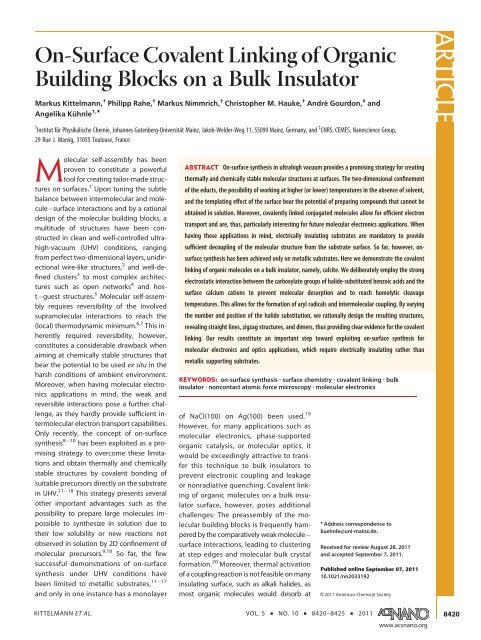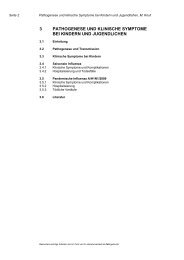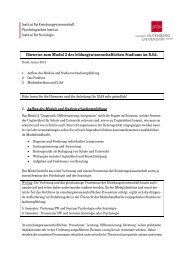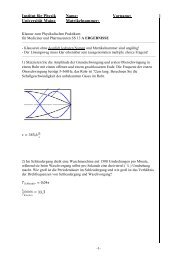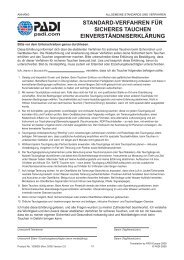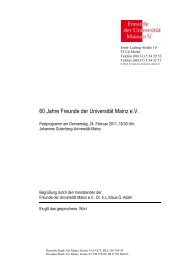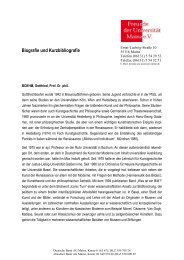KRN2011 - Johannes Gutenberg-Universität Mainz
KRN2011 - Johannes Gutenberg-Universität Mainz
KRN2011 - Johannes Gutenberg-Universität Mainz
You also want an ePaper? Increase the reach of your titles
YUMPU automatically turns print PDFs into web optimized ePapers that Google loves.
On-Surface Covalent Linking of Organic<br />
Building Blocks on a Bulk Insulator<br />
Markus Kittelmann, † Philipp Rahe, † Markus Nimmrich, † Christopher M. Hauke, † André Gourdon, ‡ and<br />
Angelika Kühnle †,*<br />
† ‡<br />
Institut für Physikalische Chemie, <strong>Johannes</strong> <strong>Gutenberg</strong>-<strong>Universität</strong> <strong>Mainz</strong>, Jakob-Welder-Weg 11, 55099 <strong>Mainz</strong>, Germany, and CNRS, CEMES, Nanoscience Group,<br />
29 Rue J. Marvig, 31055 Toulouse, France<br />
Molecular self-assembly has been<br />
proven to constitute a powerful<br />
tool for creating tailor-made structures<br />
on surfaces. 1 Upon tuning the subtle<br />
balance between intermolecular and molecule<br />
surface interactions and by a rational<br />
design of the molecular building blocks, a<br />
multitude of structures have been constructed<br />
in clean and well-controlled ultrahigh-vacuum<br />
(UHV) conditions, ranging<br />
from perfect two-dimensional layers, unidirectional<br />
wire-like structures, 2 and well-defined<br />
clusters 3 to most complex architectures<br />
such as open networks 4 and host<br />
guest structures. 5 Molecular self-assembly<br />
requires reversibility of the involved<br />
supramolecular interactions to reach the<br />
(local) thermodynamic minimum. 6,7 This inherently<br />
required reversibility, however,<br />
constitutes a considerable drawback when<br />
aiming at chemically stable structures that<br />
bear the potential to be used ex situ in the<br />
harsh conditions of ambient environment.<br />
Moreover, when having molecular electronics<br />
applications in mind, the weak and<br />
reversible interactions pose a further challenge,<br />
as they hardly provide sufficient intermolecular<br />
electron transport capabilities.<br />
Only recently, the concept of on-surface<br />
synthesis 8 10 has been exploited as a promising<br />
strategy to overcome these limitations<br />
and obtain thermally and chemically<br />
stable structures by covalent bonding of<br />
suitable precursors directly on the substrate<br />
in UHV. 11 18 This strategy presents several<br />
other important advantages such as the<br />
possibility to prepare large molecules impossible<br />
to synthesize in solution due to<br />
their low solubility or new reactions not<br />
observed in solution by 2D confinement of<br />
molecular precursors. 9,18 So far, the few<br />
successful demonstrations of on-surface<br />
synthesis under UHV conditions have<br />
11 17<br />
been limited to metallic substrates,<br />
and only in one instance has a monolayer<br />
ABSTRACT On-surface synthesis in ultrahigh vacuum provides a promising strategy for creating<br />
thermally and chemically stable molecular structures at surfaces. The two-dimensional confinement<br />
of the educts, the possibility of working at higher (or lower) temperatures in the absence of solvent,<br />
and the templating effect of the surface bear the potential of preparing compounds that cannot be<br />
obtained in solution. Moreover, covalently linked conjugated molecules allow for efficient electron<br />
transport and are, thus, particularly interesting for future molecular electronics applications. When<br />
having these applications in mind, electrically insulating substrates are mandatory to provide<br />
sufficient decoupling of the molecular structure from the substrate surface. So far, however, onsurface<br />
synthesis has been achieved only on metallic substrates. Here we demonstrate the covalent<br />
linking of organic molecules on a bulk insulator, namely, calcite. We deliberately employ the strong<br />
electrostatic interaction between the carboxylate groups of halide-substituted benzoic acids and the<br />
surface calcium cations to prevent molecular desorption and to reach homolytic cleavage<br />
temperatures. This allows for the formation of aryl radicals and intermolecular coupling. By varying<br />
the number and position of the halide substitution, we rationally design the resulting structures,<br />
revealing straight lines, zigzag structures, and dimers, thus providing clear evidence for the covalent<br />
linking. Our results constitute an important step toward exploiting on-surface synthesis for<br />
molecular electronics and optics applications, which require electrically insulating rather than<br />
metallic supporting substrates.<br />
KEYWORDS: on-surface synthesis . surface chemistry . covalent linking . bulk<br />
insulator . noncontact atomic force microscopy . molecular electronics<br />
of NaCl(100) on Ag(100) been used. 19<br />
However, for many applications such as<br />
molecular electronics, phase-supported<br />
organic catalysis, or molecular optics, it<br />
would be exceedingly attractive to transfer<br />
this technique to bulk insulators to<br />
prevent electronic coupling and leakage<br />
or nonradiative quenching. Covalent linking<br />
of organic molecules on a bulk insulator<br />
surface, however, poses additional<br />
challenges: The preassembly of the molecular<br />
building blocks is frequently hampered<br />
by the comparatively weak molecule<br />
surface interactions, leading to clustering<br />
at step edges and molecular bulk crystal<br />
formation. 20 Moreover, thermal activation<br />
of a coupling reaction is not feasible on many<br />
insulating surface, such as alkali halides, as<br />
most organic molecules would desorb at<br />
* Address correspondence to<br />
kuehnle@uni-mainz.de.<br />
Received for review August 28, 2011<br />
and accepted September 7, 2011.<br />
Published online September 07, 2011<br />
10.1021/nn2033192<br />
C 2011 American Chemical Society<br />
KITTELMANN ET AL. VOL. 5 ’ NO. 10 ’ 8420–8425 ’ 2011<br />
www.acsnano.org<br />
ARTICLE<br />
8420
temperatures below the reaction temperature. Finally,<br />
in most cases the metallic substrate seems to have a<br />
catalytic role in the coupling reaction, 21 raising the<br />
question as to whether similar reactions can be observed<br />
on an insulator. These are some of the reasons<br />
why on-surface synthesis has not been demonstrated<br />
on a bulk insulator so far.<br />
Herein we present the covalent coupling of four<br />
different halide-substituted benzoic acids (for an overview<br />
see Figure 1), namely, 2,5-diiodobenzoic acid (DIBA),<br />
2,5-dichlorobenzoic acid (DCBA), 3,5-diiodosalicylic acid<br />
(DISA), and 4-iodobenzoic acid (IBA) on a bulk insulator,<br />
namely, calcite. The carboxylic acid moiety is known to<br />
bind strongly toward calcite; 22 thus, compared to other<br />
insulating surfaces, the carboxylic acid calcite system<br />
has revealed very promising results in terms of substratetemplated<br />
molecular self-assembly. 23 Here, the comparatively<br />
high molecule substrate binding strength is employed<br />
to prevent clustering at step edges and to avoid<br />
desorption upon thermal activation of the coupling<br />
reaction. Our results indicate that the carboxylic acid<br />
group deprotonates before covalent linking. The presenceofthecarboxylategroup,<br />
being a strong electron<br />
donor, is expected to weaken the phenyl halide bond<br />
and, therefore, favor homolytic cleavage of this bond to<br />
give reactive phenyl radicals at moderate temperatures<br />
without the need of a coupling catalyst.<br />
Upon deposition at room temperature (RT), DIBA and<br />
DCBA form extended and highly ordered monolayers,<br />
which undergo a clear transition into straight molecular<br />
wires upon thermal activation, as unraveled by noncontact<br />
atomic force microscopy (NC-AFM). The observed<br />
structures fit excellently in size with a model of a<br />
covalently bound, completely conjugated molecular row.<br />
When changing the position of the halide substitution<br />
from 2,5 to 3,5 as in 3,5-diiodosalicylic acid, again a<br />
distinct structural transition can be observed upon<br />
thermal activation; however, in this case zigzag instead<br />
of straight structures are revealed. Finally, when having<br />
only one halide atom per molecule, dimers instead of<br />
extended rows are expected to form upon covalent<br />
linking. Indeed, thermal activation of 4-iodobenzoic<br />
acid results in the formation of dimer-like molecular<br />
structures that fit in size to the expected reaction<br />
product, 4,4-biphenyldicarboxylic acid (BPDCA).<br />
Comparison with a benzoic acid of similar acidity but<br />
without the halide functionality (2,5-dihydroxybenzoic<br />
acid, DHBA) exhibits no intermolecular coupling and,<br />
therefore, provides further evidence for the specificity<br />
of the observed reactions.<br />
RESULTS AND DISCUSSION<br />
First, a submonolayer coverage of DIBA is deposited<br />
onto a freshly cleaved calcite (10 14) surface held at<br />
RT. After deposition, the resulting structure is observed<br />
by NC-AFM. An overview image is shown in Figure 2a,<br />
Figure 1. Models of the used organic molecules comprising<br />
2,5-diiodobenzoic acid (DIBA), 2,5-dichlorobenzoic acid<br />
(DCBA), 3,5-diiodosalicylic acid (DISA), 4-iodobenzoic acid<br />
(IBA), 2,5-dihydroxybenzoic acid (DHBA), and 4,4-biphenyldicarboxylic<br />
acid (BPDCA).<br />
Figure 2. Covalent linking of DIBA. (a) Overview NC-AFM<br />
image of the as-deposited structure at RT, showing one<br />
monolayer high islands. Inset: Drift-corrected detailed NC-<br />
AFM image, revealing a (5 1) unit cell. (b) NC-AFM image of<br />
DIBA after annealing above 530 K (here: 555 K). The structures<br />
decorating step edges and rows are observed growing<br />
along the [421] direction. (c) Detailed NC-AFM image,<br />
showing two molecular rows and the substrate with atomic<br />
resolution. (d) Height profile as indicated in Figure 1c,<br />
revealing a repeat distance of 0.41 nm, in excellent agreement<br />
with a reacted molecular chain. (e) Model explaining<br />
the reacted structure.<br />
revealing two calcite terraces that are covered by<br />
molecular islands with an apparent height of approximately<br />
0.7 nm. From this image it can be concluded<br />
that individual DIBA molecules are mobile and diffuse<br />
on the surface to form extended stable monolayers.<br />
A close-up of this structure exhibits a highly ordered<br />
structure as shown in the drift-corrected image 24 presented<br />
in the inset in Figure 2a. A detailed analysis<br />
reveals a (5 1) superstructure exhibiting a moiré<br />
pattern (for details see Supplementary Figure S1).<br />
Molecular dynamics calculations 22 suggest that molecules<br />
containing a carboxylic acid moiety anchor to<br />
the calcite surface with the carboxylic group binding to<br />
a surface oxygen and calcium atom in an upright<br />
fashion. However, the binding is of course greatly<br />
influenced by the protonation or deprotonation state<br />
of the acid. For DIBA, having a calculated pKa of 2.51<br />
KITTELMANN ET AL. VOL. 5 ’ NO. 10 ’ 8420–8425 ’ 2011<br />
www.acsnano.org<br />
ARTICLE<br />
8421
(i.e., in vacuo), our results comparing benzoic acids with<br />
different acidity indicate that DIBA molecules are<br />
already deprotonated at RT. We note that the listed<br />
pKa values must not be taken too literally, as adsorption<br />
onto the surface might have a significant influence.<br />
However, the general trend in acidity should be reflected<br />
correctly by considering the calculated (in<br />
vacuo) values. Thus, in the case of DIBA we expect<br />
the negatively charged carboxylate group to anchor to<br />
the calcium ions. This is in agreement with the abovedrawn<br />
conclusion of upright-standing molecules. As<br />
for the deprotonation of other carboxylic acids on<br />
surfaces, we cannot clarify the question as to whether<br />
the dissociated hydrogen atoms remain on the surface<br />
or not. However, it appears likely that the protons bind<br />
to the oxygen atoms of the carbonate group.<br />
When annealing the DIBA sample to a temperature<br />
above 530 K, a completely different situation is present,<br />
as shown in Figure 2b. Now, in contrast to what was<br />
observed before at RT, no extended islands are formed,<br />
but rows running along the [421] direction. The<br />
rows shown in Figure 2b decorate the step edges<br />
(one step edge is running from the lower left to the<br />
upper right part of the image). This drastic change in<br />
molecular structure is explained by thermolytic dissociation<br />
of the two iodine atoms from the molecule and<br />
subsequent covalent linking of the radical molecules.<br />
As the iodine atoms are substituted at the 2 and 5<br />
positions, i.e., at opposite positions, a straight row is<br />
expected upon covalent linking. A detailed view given in<br />
the drift-corrected image in Figure 2c reveals a highly<br />
ordered structure that fits in size with molecules forming<br />
a row after iodine dissociation and reaction of radicals.<br />
From a height profile taken at a line indicated in Figure<br />
1c, a repeat distance of 0.41 nm is revealed (Figure 2d).<br />
This distance is in excellent agreement with a model<br />
of a reacted, completely conjugated chain as shown in<br />
Figure 2e. In this model, the molecule is again anchored<br />
toward the surface with the carboxylate groups as<br />
discussed before. In order to allow for covalent bond<br />
formation at the previous iodine positions, the molecules<br />
have to tilt at an angle of approximately 60°<br />
between the main molecular axis and the surface. This<br />
tilt results in a calculated reduction of the apparent<br />
height from nominally 0.75 nm for the iodine-free<br />
molecules to 0.65 nm. Experimentally, we reveal an<br />
apparent height of 0.45 nm, which is somewhat smaller<br />
than the expected value. However, we need to stress<br />
that different interaction forces greatly influence height<br />
measurements in NC-AFM, readily explaining this height<br />
difference.<br />
The same reaction pathway is expected for DCBA,<br />
where the iodine atoms are replaced by chlorine<br />
atoms. DCBA has basically the same pKa value of 2.50,<br />
but a higher carbon halide bond strength (C Cl: 397<br />
kJ/mol versus C I: 268 kJ/mol). On the basis of the<br />
binding energies alone, very high thermolytic cleavage<br />
Figure 3. Covalent linking of DISA. (a) NC-AFM image of<br />
DISA deposited onto the calcite surface held at RT, revealing<br />
a commensurate (1 1) structure. (b) Detailed NC-AFM image<br />
of the sample after annealing to 580 K, revealing a<br />
distinctly different molecular structure. A zigzag pattern is<br />
obtained as marked by a rectangle. (c) Close-up of the<br />
marked area in (b) with a superimposed model of the<br />
covalently linked molecules. (d) Model of the different<br />
structures possible upon covalent linking. Besides a zigzag<br />
row, also other, kinked and circular patterns are possible.<br />
temperatures would be expected. Interestingly, in a<br />
recent study, thermolytic cleavage of bromine has<br />
been achieved at 590 K within a molecule sublimator<br />
(i.e., in the absence of a metallic surface). 17 In our case,<br />
as mentioned above, the carboxylate formation and<br />
the interaction with the surface are expected to facilitate<br />
the homolytic cleavage. Thus, exclusively considering<br />
the bond strengths certainly oversimplifies the<br />
situation. We do, however, expect that somewhat<br />
higher temperatures are required when repeating the<br />
same experiments with DCBA instead of DIBA. We have<br />
done this experiment (not shown) and, indeed, find the<br />
same structures, but at an increased transition temperature,<br />
which has to be raised above 565 K for<br />
inducing covalent linking, supporting the conclusion<br />
above.<br />
After annealing, we observe an increased defect<br />
density in the case of both DIBA and DCBA. These<br />
defects might arise from the dissociated iodine and<br />
chlorine atoms, respectively. However, we speculate<br />
that most of the dissociated iodine and chlorine atoms<br />
desorb upon annealing.<br />
One may speculate that the structural changes<br />
observed are due only to a deprotonation of the<br />
carboxylic acid, which might be accompanied with a<br />
structural change. In order to exclude this possibility,<br />
we have checked the structures formed by DHBA,<br />
where the halide atoms are replaced by hydroxyl<br />
groups. DHBA has a pKa of 2.97, which is somewhat<br />
higher than the pKa of the two acids tested above.<br />
Right after deposition, we observe a coexistence of two<br />
KITTELMANN ET AL. VOL. 5 ’ NO. 10 ’ 8420–8425 ’ 2011<br />
www.acsnano.org<br />
ARTICLE<br />
8422
different structures, one of which is a transient structure<br />
that transform with time (and after annealing to<br />
440 K) into the more stable structure, exhibiting a (1 5)<br />
unit cell. We tentatively ascribe this transition to the<br />
deprotonation step (see Supplementary Figure S2 and<br />
Table S1). Upon annealing this structure to 520 K, the<br />
ordered structure vanishes, leaving behind an unordered<br />
structure of probably fragmented molecules.<br />
This structure remains on the surface for all temperatures<br />
accessible. Most importantly, no structure is<br />
found that resembles the molecular row structure as<br />
observed before in the cases of DIBA and DCBA. This is<br />
a further confirmation for the specifity of the above<br />
shown covalent linking.<br />
Next, we have changed the substitution position<br />
from 2,5 to 3,5 with the objective to create a zigzag<br />
structure after covalent linking. As 3,5-diiodobenzoic<br />
acid was not available for this study, 3,5-diiodosalicylic<br />
acid is used instead, having a pK a of 2.07. This low pK a<br />
value suggests the molecules to be already deprotonated<br />
at RT. The as-deposited structure is shown in<br />
Figure 3a, revealing a commensurate (1 1) superstructure<br />
with an apparent height of 0.6 nm, which<br />
agrees with upright-standing molecules. Annealing<br />
this sample to 580 K again results in a distinctly<br />
different molecular pattern, as shown in Figure 3b. In<br />
this image, molecular features of differing shape are<br />
observed. The apparent height of these structures is on<br />
the order of 0.35 nm, suggesting flat-lying molecules in<br />
this case. Among them, zigzag structures are, indeed,<br />
obtained, as marked by a rectangle in the center of the<br />
image. An enlarged view is given in Figure 3c along<br />
with a model of covalently linked poly(metaphenyl)<br />
molecules forming a zigzag row. The observed transition<br />
from standing molecules at RT to lying molecular<br />
structures upon annealing can be readily understood<br />
by considering the position of the carboxylate groups.<br />
In the case of individual DISA molecules, all molecules<br />
can arrange with the carboxylate groups pointing<br />
toward the calcite surface, resulting in a layer of upright-standing<br />
molecules. After reaction, however, the<br />
carboxylate groups point in opposite directions, which<br />
prevents concerted binding of these groups to the<br />
surface, explaining the transition from standing to flatlying<br />
molecules. Besides zigzag structures, DISA can<br />
form other patterns, which occur when the molecules<br />
link with a different angle, as illustrated in Figure 3d.<br />
This fact readily explains the less ordered appearance<br />
of DISA upon annealing as compared to the structures<br />
observed after annealing of DIBA, as only straight lines<br />
are possible in the latter case. The structural change<br />
from straight lines as observed for 2,5-substituted DIBA<br />
and DCBA to aggregates with a kinked linking in the<br />
case of 3,5-substituted DISA constitutes a further<br />
strong confirmation of the above-drawn conclusion<br />
of covalent linking.<br />
Figure 4. Covalent linking of IBA. (a) Upon moderate annealing<br />
of the IBA-covered sample to a temperature of<br />
520 K, two domains are revealed, exhibiting a large-scale<br />
moiré modulation. Inset: Close-up of one of the domains,<br />
exhibiting a (8 1) unit cell. (b) Molecular structure of the<br />
IBA-covered substrate after annealing to 580 K showing<br />
molecular rows running along the [421] direction. Two or<br />
more rows align, resulting in double rows and larger<br />
arrangements. The rows are composed of individually resolved<br />
features that are aligned side-by-side. Ellipses having<br />
the size of the expected reaction product, BPDCA, are<br />
superimposed onto the row. (c) Close-up of a single molecular<br />
row with superimposed BPCDA model molecules.<br />
Due to a tip-convolution effect, the row is imaged with a<br />
“halo”, which is a known artifact in AFM imaging. Along the<br />
[010] direction, lines are drawn that superimpose with the<br />
bright calcite features (protruding oxygen atoms of one<br />
type of carbonate group). Along the [421] direction, the<br />
lines are superimposed onto the less bright features<br />
(protruding oxygen atoms of the opposite type of carbonate<br />
group). (d) Structural model showing the flat-lying<br />
molecules with the carboxylate groups adsorbed on top of<br />
two calcium ions of the substrate.<br />
As a further evidence for the coupling reaction, we<br />
next discuss reducing the number of halide atoms at<br />
the phenyl ring from two to one. Molecules with only<br />
one halide atom are expected to form dimers instead<br />
of extended wires upon covalent linking. To follow this<br />
approach, 4-iodobenzoic acid with a pKa of 4.02 is<br />
deposited onto freshly cleaved calcite. Due to the<br />
comparatively high pKa value, the molecules remain<br />
protonated at RT, as is evident from a further structural<br />
transition observed upon moderate annealing to 520 K<br />
before inducing covalent coupling at higher temperatures<br />
as explained in the following.<br />
At RT, extended two-dimensional islands with an<br />
apparent height of 0.5 nm and an internal hexagonal<br />
ordering are revealed (see Supplementary Figure S3).<br />
Upon moderate annealing at 520 K, a first structural<br />
change is observed. After this annealing step, two<br />
domains of extended islands are observed; however,<br />
the apparent height increases to 0.8 nm (see Figure 4a).<br />
A highly ordered structure can be resolved within the<br />
domains (see inset in Figure 4a), revealing a (8 1) unit<br />
KITTELMANN ET AL. VOL. 5 ’ NO. 10 ’ 8420–8425 ’ 2011<br />
www.acsnano.org<br />
ARTICLE<br />
8423
cell. The change in apparent height suggests a transition<br />
from lying to upright-standing molecules upon<br />
moderate annealing. This structural change is ascribed<br />
to the deprotonation of the molecules, taking place at<br />
higher temperatures as compared to the three other<br />
benzoic acids discussed above. This can be understood<br />
by comparing the pKa values (4.02 versus 2.51 (DIBA),<br />
2.50 (DCBA), and 2.07 (DISA)). Thus, the molecules are<br />
assumed to bind as negatively charged carboxylates<br />
(for details, see Supplementary Table S1). In an attempt<br />
to deiodize the IBA molecules and to induce a covalent<br />
linking of the remaining radical molecules to form<br />
biphenyldicarboxylic acid molecules, the molecules<br />
are further annealed to thermally activate the deiodization<br />
and subsequent linking. Annealing an IBA-covered<br />
calcite surface to 580 K again results in a<br />
significant structural change. As shown in Figure 4b,<br />
now rows are obtained that are oriented along the<br />
[421] calcite direction. The apparent height of the rows<br />
is 0.4 nm, suggesting flat-lying molecules. The rows are<br />
composed of features that fit excellently in size with<br />
BPDCA molecules aligned side-by-side, as illustrated by<br />
the superimposed ellipses with the size of BPDCA<br />
molecules (Figure 4b). Often, two or more rows are<br />
observed to align, resulting in double rows and larger<br />
arrangements. However, single rows exist as well, as<br />
shown in Figure 4c. On the basis of these data, which<br />
reveal both the molecular rows and the calcite lattice<br />
simultaneously, the molecule adsorption position can<br />
be determined unambiguously. The calcite lattice reveals<br />
pronounced reconstructions, a (2 1) reconstruction<br />
and the so-called row pairing, allowing for an<br />
identification of the lattice sites. 25 The lines drawn<br />
along the [010] direction in Figure 4c are superimposed<br />
onto the bright features of the calcite surface, which<br />
are ascribed to the protruding oxygen atoms of carbonate<br />
groups having the same orientation. The lines in<br />
the [421] direction are placed in a way that they<br />
superimpose the less bright features, which are known<br />
to be the oxygen atoms of the carbonate groups<br />
having the opposite orientation within the unit cell.<br />
As can be seen, the molecular row is centered<br />
in between the lines drawn in the [421] direction.<br />
The molecules within the row are centered on the<br />
lines superimposed along the [010] direction. With<br />
this information, a precise structural model can be<br />
METHODS<br />
Calcite Preparation. Optical quality calcite samples from Korth<br />
Kristalle GmbH (Kiel, Germany) are cleaved in situ, resulting in<br />
flat (104) cleavage planes. 26 Right after cleavage, the crystals are<br />
heated to 480 K for about one hour to remove surface charges.<br />
Molecule Deposition. The molecules were purchased from<br />
Aldrich (Munich, Germany) and thoroughly outgassed at RT<br />
for 60 h prior to use. All molecules are sublimated in situ onto<br />
constructed, as given in Figure 4d. In this model, we<br />
assume the reacted IBA molecules to be deprotonated,<br />
as suggested by the structural change observed upon<br />
moderate annealing. The size of a deprotonated BPDCA<br />
molecule allows for an excellent alignment of the<br />
negatively charged carboxylate groups on top of two<br />
calcium ions of the substrate, which is exactly what we<br />
obtain from the model. The measured molecular spacing<br />
along the [421] direction of 0.81 nm reflects the<br />
spacing of every two calcium ions along this direction.<br />
Along the [010] direction, the measured spacing of<br />
2.07 nm between adjacent rows again reflects the<br />
calcite lattice dimensions (four times 0.51 nm) and,<br />
thus, further supports the assumption of a welldefined<br />
adsorption position in the case of covalently<br />
linked IBA molecules. We take the excellent agreement<br />
in size and the very reasonable spacing with<br />
respect to the calcite substrate as strong indications<br />
for the reaction of IBA to deprotonated BPDCA. Moreover,<br />
the transition in the molecular orientation from<br />
standing upright to lying down provides further<br />
evidence for the covalent linking. After the reaction,<br />
the carboxylic groups point in opposite directions,<br />
making concerted binding of the carboxylate groups<br />
to the calcite impossible. As a consequence, the<br />
dimers are expected to lie flat on the surface,<br />
which is, indeed, observed. Finally, a direct comparison<br />
with BPDCA molecules further reveals the structural<br />
similarity of the reacted IBA and as-deposited<br />
BPDCA molecules (see Supplementary Figure S4),<br />
serving as a further confirmation of the above-drawn<br />
conclusion.<br />
CONCLUSION<br />
To conclude, we have demonstrated the covalent<br />
linking of halide-substituted benzoic acid molecules by<br />
thermal activation on a bulk insulator, namely, the<br />
(104) cleavage plane of calcite. The resulting products<br />
constitute conjugated molecular structures on a truly<br />
insulating support, providing electronic decoupling<br />
from the substrate, which is mandatory for future<br />
applications. By comparison of different substitution<br />
positions as well as changing the number of halidesubstituted<br />
atoms, we demonstrate the specificity of<br />
this approach. Our results pave the way for application<br />
of on-surface synthesis on bulk insulators.<br />
the freshly prepared calcite surface using home-built Knudsen<br />
cells.<br />
NC-AFM Imaging. All experiments are carried out under UHV<br />
conditions (base pressure e1 10 10 mbar) using a VT AFM 25<br />
atomic force microscope (Omicron, Taunusstein, Germany)<br />
operated in the frequency modulation noncontact mode (NC-<br />
AFM). The system is equipped with an easyPLL Plus controller<br />
and phase-locked loop detector (Nanosurf, Liestal, Switzerland)<br />
KITTELMANN ET AL. VOL. 5 ’ NO. 10 ’ 8420–8425 ’ 2011<br />
www.acsnano.org<br />
ARTICLE<br />
8424
for oscillation excitation and signal demodulation. We use<br />
n-doped silicon cantilevers (NanoWorld, Neuch^atel, Switzerland)<br />
with resonance frequencies of around 300 kHz (type PPP-NCH)<br />
excited to oscillation amplitudes of about 10 nm. Prior to their<br />
use, the cantilevers were Ar þ sputtered at 2 keV for 5 min to<br />
remove contaminants. Depending on the feedback loop settings,<br />
either frequency shift (Δf)ortopography(z) images are presented<br />
here. For the Δf images, the distance feedback loop was set very<br />
slow in order to provide quasi constant-height images while still<br />
following the overall tilt of the sample surface. Image type as well<br />
as fast and slow scan directions are given in the upper right corner<br />
in each image. The images are displayed such that bright<br />
corresponds to high attractive interactions while dark corresponds<br />
to less attractive or even repulsive interactions. 27<br />
Thermal Activation Step. The molecules are thermally activated<br />
by annealing the calcite substrate with a pyrolytic boron nitride<br />
heater positioned underneath the sample. The temperature is<br />
controlled by a thermocouple mounted at the sample stage<br />
about 2.5 cm apart from the sample. The temperature specifications<br />
given here are the corresponding temperatures expected at<br />
the calcite sample based on an individual calibration curve<br />
supplied by the manufacturer (Omicron, Taunusstein, Germany).<br />
Acknowledgment. A.K. acknowledges support by the German<br />
Research Foundation (DFG) through the SFB 625 grant TP<br />
B17.<br />
Supporting Information Available: Further NC-AFM images<br />
as mentioned throughout the text. This material is available free<br />
of charge via the Internet at http://pubs.acs.org.<br />
REFERENCES AND NOTES<br />
1. Barth, J. V. Molecular Architectonic on Metal Surfaces.<br />
Annu. Rev. Phys. Chem. 2007, 58, 375–407.<br />
2. Barth, J. V.; Weckesser, J.; Cai, C.; Günter, P.; Bürgi, L.;<br />
Jeandupeux, O.; Kern, K. Building Supramolecular Nanostructures<br />
at Surfaces by Hydrogen Bonding. Angew. Chem.,<br />
Int. Ed. 2000, 39, 1230–1234.<br />
3. Böhringer, M.; Morgenstern, K.; Schneider, W.-D.; Berndt,<br />
R.; Mauri, F.; Vita, A. D.; Car, R. Two-Dimensional Self-<br />
Assembly of Supramolecular Clusters and Chains. Phys.<br />
Rev. Lett. 1999, 83, 324–327.<br />
4. Pawin, G.; Wong, K. L.; Kwon, K. Y.; Bartels, L. A Homomolecular<br />
Porous Network at a Cu(111). Surf. Sci. 2006,<br />
313, 961–962.<br />
5. Theobald, J. A.; Oxtoby, N. S.; Phillips, M. A.; Champness,<br />
N. R.; Beton, P. H. Controlling Molecular Deposition and<br />
Layer Structure with Supramolecular Surface Assemblies.<br />
Nature 2003, 424, 1029–1031.<br />
6. Kühnle, A. Self-Assembly of Organic Molecules at Metal<br />
Surfaces. Curr. Opin. Colloid Interface Sci. 2009, 14, 157–<br />
168.<br />
7. Whitesides, G. M.; Mathias, J. P.; Seto, C. T. Molecular Self-<br />
Assembly and Nanochemistry: A Chemical Strategy for the<br />
Synthesis of Nanostructures. Science 1991, 254, 1312–19.<br />
8. Gourdon, A. On-Surface Covalent Coupling in Ultrahigh<br />
Vacuum. Angew. Chem., Int. Ed. 2008, 47, 6950–6953.<br />
9. Franc, G.; Gourdon, A. Covalent Networks through on-<br />
Surface Chemistry in Ultra-High Vacuum: State-of-the-Art<br />
and Recent Developments. Phys. Chem. Chem. Phys. 2011,<br />
13, 14283–14292.<br />
10. Perepichka, D. F.; Rosei, F. Extending Polymer Conjugation<br />
into the Second Dimension. Science 2009, 323, 216–217.<br />
11. Cai, J. M.; Ruffieux, P.; Jaafar, R.; Bieri, M.; Braun, T.;<br />
Blankenburg, S.; Muoth, M.; Seitsonen, A. P.; Saleh, M.;<br />
Feng, X. L.; et al. Atomically Precise Bottom-up Fabrication<br />
of Graphene Nanoribbons. Nature 2010, 466, 470–473.<br />
12. Schmitz, C. H.; Ikonomov, J.; Sokolowski, M. Two-Dimensional<br />
Ordering of Poly(p-Phenylene-Terephthalamide) on<br />
the Ag(111) Surface Investigated by Scanning Tunneling<br />
Microscopy. J. Phys. Chem. C 2009, 113, 11984–11987.<br />
13. Lipton-Duffin, J. A.; Ivasenko, O.; Perepichka, D. F.; Rosei, F.<br />
Synthesis of Polyphenylene Molecular Wires by Surface-<br />
Confined Polymerization. Small 2009, 5, 592–597.<br />
14. Weigelt, S.; Busse, C.; Bombis, C.; Knudsen, M. M.; Gothelf,<br />
K. V.; Laegsgaard, E.; Besenbacher, F.; Linderoth, T. R. Surface<br />
Synthesis of 2D Branched Polymer Nanostructures.<br />
Angew. Chem., Int. Ed. 2008, 47, 4406–4410.<br />
15. Zwaneveld, N. A. A.; Pawlak, R.; Abel, M.; Catalin, D.;<br />
Gigmes, D.; Bertin, D.; Porte, L. Organized Formation of<br />
2D Extended Covalent Organic Frameworks at Surfaces.<br />
J. Am. Chem. Soc. 2008, 130, 6678–6679.<br />
16. Matena, M.; Riehm, T.; Stöhr, M.; Jung, T. A.; Gade, L. H.<br />
Transforming Surface Coordination Polymers into Covalent<br />
Surface Polymers: Linked Polycondensed Aromatics<br />
through Oligomerization of N-Heterocyclic Carbene Intermediates.<br />
Angew. Chem., Int. Ed. 2008, 47, 2414–2417.<br />
17. Grill, L.; Dyer, M.; Lafferentz, L.; Persson, M.; Peters, M. V.;<br />
Hecht, S. Nano-Architectures by Covalent Assembly of<br />
Molecular Building Blocks. Nat. Nanotechnol. 2007, 2,<br />
687–691.<br />
18. Mendez, J.; Lopez, M. F.; Martin-Gago, J. A. On-Surface<br />
Synthesis of Cyclic Organic Molecules. Chem. Soc. Rev.<br />
2011, 40, 4578–4590.<br />
19. Abel, M.; Clair, S.; Ourdjini, O.; Mossoyan, M.; Porte, L. Single<br />
Layer of Polymeric Fe-Phthalocyanine: An Organometallic<br />
Sheet on Metal and Thin Insulating Film. J. Am. Chem. Soc.<br />
2011, 133, 1203–1205.<br />
20. Kunstmann, T.; Schlarb, A.; Fendrich, M.; Wagner, T.; Möller,<br />
R.; Hoffmann, R. Dynamic Force Microscopy Study of<br />
3,4,9,10-Perylenetetracarboxylic Dianhydride on Kbr(001).<br />
Phys. Rev. B 2005, 71, 121403.<br />
21. Gutzler, R.; Walch, H.; Eder, G.; Kloft, S.; Heckl, W. M.;<br />
Lackinger, M. Surface Mediated Synthesis of 2D Covalent<br />
Organic Frameworks: 1,3,5-Tris(4-Bromophenyl)Benzene<br />
on Graphite(001), Cu(111), and Ag(110). Chem. Commun.<br />
2009, 4456–4458.<br />
22. Duffy, D. M.; Harding, J. H. Modelling the Interfaces<br />
between Calcite Crystals and Langmuir Monolayers.<br />
J. Mater. Chem. 2002, 12, 3419–3425.<br />
23. Rahe, P.; Nimmrich, M.; Greuling, A.; Schütte, J.; Stará, I. G.;<br />
Rybácek, J.; Huerta-Angeles, G.; Stary, I.; Rohlfing, M.;<br />
Kühnle, A. Toward Molecular Nanowires Self-Assembled<br />
on an Insulating Substrate: Heptahelicene-2-Carboxylic<br />
Acid on Calcite (10 14). J. Phys. Chem. C 2010, 114,<br />
1547–1552.<br />
24. Rahe, P.; Bechstein, R.; Kühnle, A. Vertical and Lateral Drift<br />
Corrections of Scanning Probe Microscopy Images. J. Vac.<br />
Sci. Technol. B 2010, 28, C4E31–C4E38.<br />
25. Schütte, J.; Rahe, P.; Tröger, L.; Rode, S.; Bechstein, R.;<br />
Reichling, M.; Kühnle, A. Clear Signature of the (2 1)<br />
Reconstruction of Calcite (10 14). Langmuir 2010, 26,<br />
8295–8300.<br />
26. Tröger, L.; Schütte, J.; Ostendorf, F.; Kühnle, A.; Reichling, M.<br />
Concept for Support and Cleavage of Brittle Crystals. Rev.<br />
Sci. Instrum. 2009, 80, 063703.<br />
27. Rahe, P.; Bechstein, R.; Schütte, J.; Ostendorf, F.; Kühnle, A.<br />
Repulsive Interaction and Contrast Inversion in Noncontact<br />
Atomic Force Microscopy Imaging of Adsorbates.<br />
Phys. Rev. B 2008, 77, 195410.<br />
KITTELMANN ET AL. VOL. 5 ’ NO. 10 ’ 8420–8425 ’ 2011<br />
www.acsnano.org<br />
ARTICLE<br />
8425


